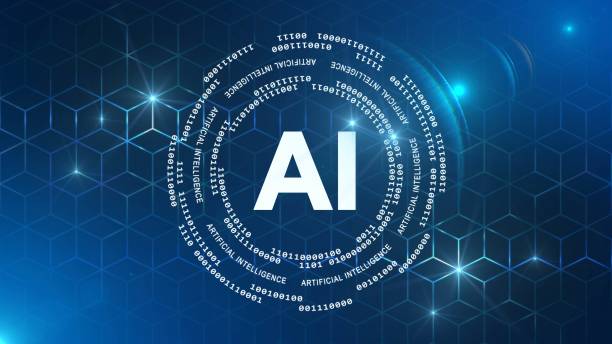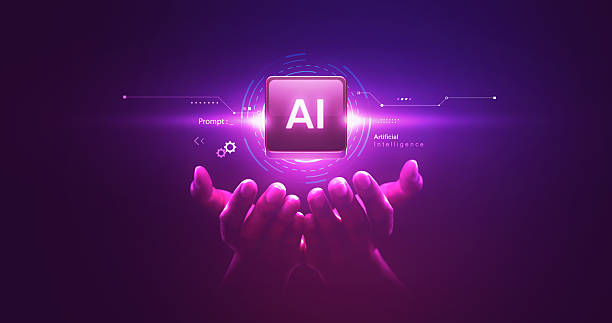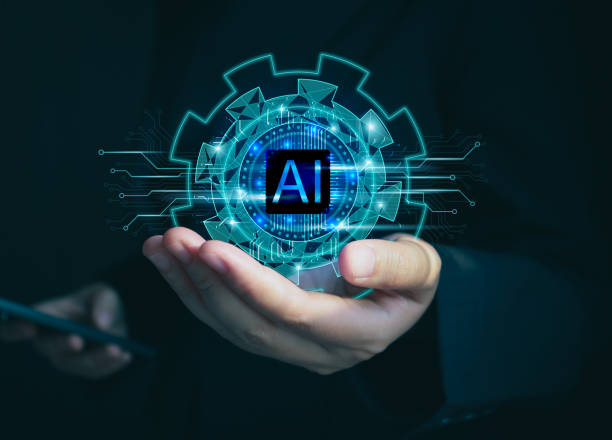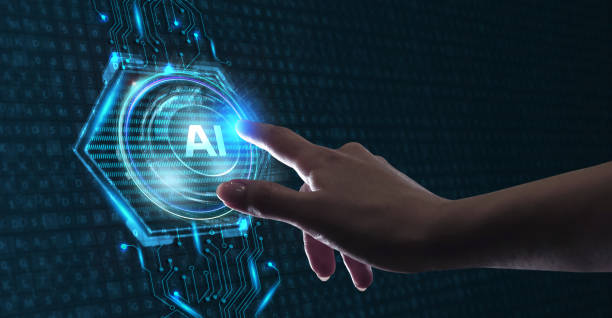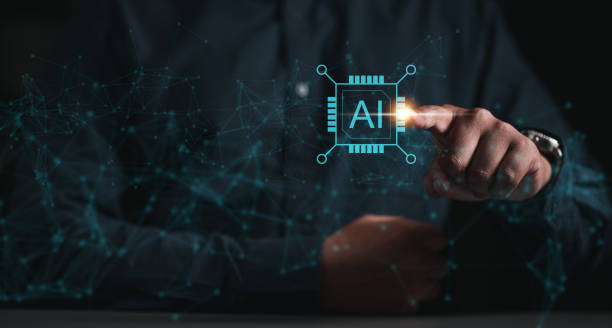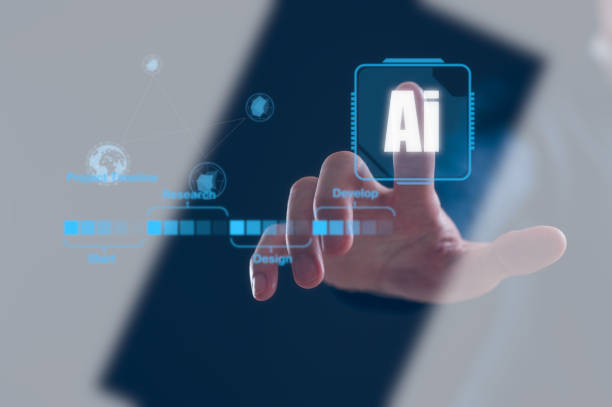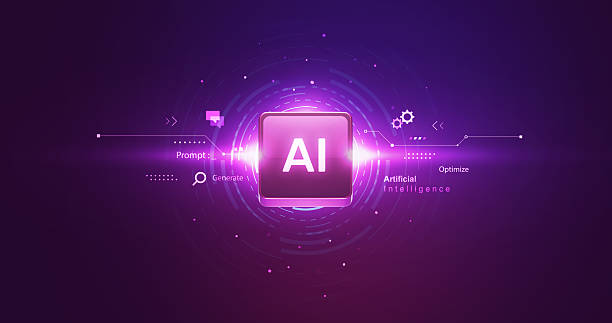What is an AI Robot and how does it work?
What is an AI Robot and how does it work?
#AI_Robot (AI Robot) is a combination of two distinct but related fields: robotics and artificial intelligence.
Robotics deals with the design, construction, operation, and application of robots.
Robots are typically machines capable of performing tasks automatically or semi-automatically.
Artificial intelligence, on the other hand, deals with the development of computer systems that can perform tasks that typically require human intelligence, such as learning, problem-solving, pattern recognition, and decision-making.
When these two fields are combined, the result is an intelligent robot that can perform more complex and adaptive tasks than traditional robots.
In other words, an AI robot is capable of collecting, analyzing, and making decisions based on information using machine learning algorithms and natural language processing.
Artificial intelligence is, in fact, the thinking brain of the robot that enables it to act intelligently in various environments.
The operation of an AI robot typically involves the following steps:
- Data Collection: The robot collects information from its surroundings using various sensors (such as cameras, microphones, touch sensors, etc.).
- Data Processing: The collected data is processed by artificial intelligence algorithms.
These algorithms can include machine learning, neural networks, and other intelligent methods. - Decision Making: Based on the processed data, the robot decides what action to take.
This decision-making can include moving, speaking, manipulating objects, etc. - Execution: The robot executes its decision using various actuators (such as motors, arms, speakers, etc.).
- Learning: The robot learns from its experiences and improves its performance.
This learning can include adjusting the parameters of AI algorithms, refining decision-making strategies, etc.
AI robots are used as powerful tools in various industries and can play a more significant role in our lives in the future.
For example, in the manufacturing industry, intelligent robots can perform repetitive and dangerous tasks.
In the service industry, intelligent robots can assist customers and provide them with the information they need.
In medicine, intelligent robots can assist doctors in surgery and disease diagnosis.
Artificial intelligence and robotics are two sides of the same coin that, by working together, make the world around us smarter.
Did you know that 94% of the first impression of a company is related to its website design?
RasaWeb, by providing professional corporate website design services, helps you create the best first impression.
✅ Create a professional and trustworthy image for your brand
✅ Easier attraction of potential customers and improvement of online presence
⚡ Get free corporate website design consultation
Types of AI Robots Based on Application
Click here to preview your posts with PRO themes ››
Types of AI Robots Based on Application
AI robots can be divided into different categories based on their application.
Each category of these robots performs specific tasks and is used in various industries and fields.
Here are some of the most important types of AI robots based on application:
- Industrial Robots: These robots are used in factories and production lines for repetitive and precise tasks.
They can perform welding, painting, packaging, and assembly of parts.
Industrial robots usually have robotic arms capable of moving in different directions and performing complex movements. - Service Robots: These robots are designed to provide services to humans.
They can be used in hospitals, hotels, restaurants, and shopping centers.
Service robots can perform tasks such as cleaning, food delivery, cargo handling, and providing information.
AI service robots are increasingly expanding and play an important role in improving people’s quality of life. - Medical Robots: These robots are used in hospitals and treatment centers to assist doctors and nurses.
They can assist in surgery, rehabilitation, and providing medical care to patients.
Medical robots usually have high precision and can perform delicate and complex movements. - Military Robots: These robots are used in armies and security forces to perform dangerous and difficult tasks.
They can assist soldiers in reconnaissance, bomb disposal, patrolling, and combat.
Military robots typically have high power and resistance and can perform well in harsh and demanding conditions. - Educational Robots: These robots are used in schools and universities to teach robotics and AI concepts to students.
They can help students learn the skills necessary for designing, building, and programming robots. - Explorer Robots: These robots are used for exploration in dangerous and unknown environments, such as space, deep sea, and radioactive contaminated areas.
They can collect valuable information and provide it to scientists and researchers.
Click here to preview your posts with PRO themes ››
In addition to the above classification, AI robots can also be classified based on the type of movement, type of control, and type of artificial intelligence used.
The selection of the appropriate type of AI robot depends on its specific application.
Key Technologies in Building AI Robots
Key Technologies in Building AI Robots
Building an AI robot requires the use of a set of advanced technologies.
These technologies include hardware, software, and artificial intelligence algorithms that, by working together, enable the intelligent and autonomous operation of the robot.
Here are some of the most important key technologies in building AI robots:
- Hardware: Robot hardware includes physical components such as the body, motors, sensors, actuators, and processors.
The robot’s body must be made of strong and lightweight materials to withstand impact and pressure.
Motors and actuators are used to move the robot and perform various tasks.
Sensors are used to collect information from the surrounding environment.
Processors are used to process information and control the robot’s operation. - Software: Robot software includes the operating system, drivers, libraries, and artificial intelligence algorithms.
The operating system is used to manage the robot’s hardware resources.
Drivers are used to communicate with sensors and actuators.
Libraries include a set of ready-made functions and classes that are used for robot software development.
Artificial intelligence algorithms are used for information processing and decision-making. - Artificial Intelligence Algorithms: AI algorithms are the thinking brain of the robot and enable it to perform tasks that typically require human intelligence.
Some of the most important AI algorithms used in robots include machine learning, neural networks, natural language processing, and computer vision.
AI algorithms allow the robot to learn from data, recognize patterns, understand human language, and see images.
The combination of these technologies enables the robot to operate intelligently in various environments and perform complex tasks.
| Technology | Description |
|---|---|
| Hardware | Includes physical components such as body, motors, sensors, and processors |
| Software | Includes operating system, drivers, libraries, and artificial intelligence algorithms |
| Artificial Intelligence Algorithms | Includes machine learning, neural networks, natural language processing, and computer vision |
Challenges and Limitations of AI Robots
Challenges and Limitations of AI Robots
Despite significant advancements in robotics and artificial intelligence, there are still challenges and limitations that prevent the widespread application of AI robots in some areas.
Some of the most important challenges and limitations include:
- High Cost: Designing, building, and maintaining AI robots usually involves high costs.
This cost includes the cost of purchasing components, software development costs, and human resource training costs.
High costs can prevent the use of AI robots in small and medium-sized businesses. - Complexity: AI robots are complex systems that require high knowledge and expertise for design, construction, and programming.
Complexity can prevent the use of AI robots by non-specialists. - Security: AI robots can be vulnerable to cyberattacks.
Hackers can take control of the robot and use it to perform malicious actions.
AI robot security is an important issue that needs special attention. - Ethical Issues: The use of AI robots can raise various ethical issues.
For example, if an autonomous robot causes an accident, who will be responsible? If a robot replaces a human worker, what will happen to that worker? Ethical issues related to AI robots need to be carefully examined. - Technical Limitations: AI robots still have technical limitations in some areas.
For example, they cannot understand emotions and empathize with humans as well as humans can.
They also cannot be as creative as humans and come up with new ideas.
Overcoming these challenges and limitations requires the joint efforts of researchers, engineers, policymakers, and ethics experts.
By solving these problems, AI robots can be used more widely in various industries and fields, and their benefits can be enjoyed.
Are you dissatisfied with the low conversion rate of visitors to customers on your e-commerce site?
Solve this problem forever with professional e-commerce website design by RasaWeb!
✅ Increase visitor-to-customer conversion rate
✅ Create an excellent user experience and build customer trust
⚡ Get free consultation
The Future of AI Robots and their Impact on Human Life
The Future of AI Robots and their Impact on Human Life
The future of AI robots is very bright and full of potential.
With continuous advancements in artificial intelligence and robotics, robots are expected to play a more significant role in human life in the future.
They can help improve productivity in various industries, contribute to providing services to humans, and even assist us in space exploration.
AI robots are gradually becoming an integral part of our lives.
The impact of AI robots on human life can be very extensive and profound.
Some of the most important potential impacts include:
- Changes in the Job Market: AI robots can automate many jobs.
This can lead to job losses for some individuals.
However, robots can also create new jobs and help humans focus on more creative and strategic tasks. - Improved Health and Treatment: AI robots can assist in surgery, rehabilitation, and providing medical care to patients.
They can increase the accuracy and speed of surgeons and help patients recover faster.
AI robots can also help the elderly and people with disabilities lead more independent lives. - Increased Productivity: AI robots can help increase productivity in various industries.
They can perform repetitive and dangerous tasks and help humans focus on more important tasks.
AI robots can also help improve the quality of products and services. - Changes in Lifestyle: AI robots can change our lifestyle.
They can help us with daily tasks, such as cleaning the house, cooking, and shopping.
AI robots can also help us with learning, entertainment, and connecting with others.
To benefit from AI robots and prevent their potential risks, we must pay special attention to the ethical and social issues related to them.
We must ensure that robots are designed and used in a way that benefits humans and respects their rights and values.
AI robots have brought us an exciting future full of opportunities.
Case Study: Application of AI Robots in Various Industries
Case Study: Application of AI Robots in Various Industries
To better understand the application of AI robots, let’s examine their use in various industries:
- Manufacturing Industry: In the manufacturing industry, AI robots are used for repetitive and dangerous tasks such as welding, painting, packaging, and assembling parts.
These robots can help increase production speed and accuracy, reduce costs, and improve product quality.
For example, Tesla uses AI robots to assemble its cars in its factories. - Service Industry: In the service industry, AI robots are used to provide customer services, such as answering questions, providing information, and processing transactions.
These robots can help reduce customer waiting times, improve customer satisfaction, and lower operating costs.
For example, many banks and telecommunications companies use chatbot robots to answer customer questions on their websites and mobile applications. - Healthcare Industry: In the healthcare industry, AI robots are used to assist doctors and nurses in diagnosing diseases, performing surgeries, rehabilitating patients, and providing medical care.
These robots can help increase the accuracy and speed of disease diagnosis, improve surgical outcomes, accelerate patient rehabilitation, and reduce healthcare costs.
For example, the Da Vinci robot is used for minimally invasive surgeries in many hospitals. - Agriculture Industry: In the agriculture industry, AI robots are used for tasks such as planting, cultivating, and harvesting crops, irrigation, spraying, and pest control.
These robots can help increase productivity, reduce costs, and improve the quality of agricultural products.
For example, agricultural robots can use sensors and AI algorithms to detect the amount of water needed by each plant and perform irrigation automatically.
These are just a few examples of the application of AI robots in various industries.
With continuous advancements in this field, the applications of robots are expected to become more extensive and diverse in the future.
How to Choose and Implement the Right AI Robot for Business
How to Choose and Implement the Right AI Robot for Business
Choosing and implementing the right AI robot for business is a complex process that requires careful consideration of the business’s needs, resources, and goals.
Here are some of the most important steps in this process:
- Determine Needs and Goals: First and foremost, you need to carefully determine your business’s needs and goals.
What problems do you want to solve using an AI robot? What goals do you want to achieve using it? Answering these questions will help you determine the right type of AI robot for your business. - Review Available Options: After determining needs and goals, you need to review the available options.
What types of AI robots are available on the market? Which ones best meet your needs? What is the price of each? Reviewing available options will help you choose the best option. - Evaluate Risks and Benefits: Before making a final decision, you need to evaluate the risks and benefits of each option.
What risks might arise when using an AI robot? What benefits might you gain from using it? Evaluating risks and benefits will help you make an informed decision. - Implementation and Training: After choosing the right AI robot, you need to implement it and train your employees on how to use it.
Proper implementation and training will help you use the AI robot effectively and achieve your goals. - Monitoring and Improvement: After implementation, you need to continuously monitor the performance of the AI robot and improve it if necessary.
Continuous monitoring and improvement will help you use the AI robot effectively and create more value for your business.
By following these steps, you can select and implement the appropriate AI robot for your business and reap its benefits.
Important Tips for Maintaining and Optimizing AI Robot Performance
Important Tips for Maintaining and Optimizing AI Robot Performance
Maintaining and optimizing the performance of AI robots is essential to ensure their correct and efficient operation.
Here are some of the most important tips in this regard:
- Software Updates: Regularly update the AI robot’s software to benefit from the latest features and security improvements.
Software updates can help improve performance, increase security, and fix software bugs. - Cleaning and Inspection: Periodically clean and inspect the AI robot to ensure the integrity of its components and the absence of physical problems.
Regular cleaning and inspection can help prevent breakdowns and extend the robot’s lifespan. - Staff Training: Continuously train your employees on how to use the AI robot correctly and safely.
Staff training can help prevent human errors and improve robot performance. - Data Backup: Regularly back up the AI robot’s data so that you can restore your data in case of a problem.
Data backup can prevent the loss of important information. - Performance Monitoring: Continuously monitor the AI robot’s performance to ensure its correct and efficient operation.
Performance monitoring can help identify problems and improve robot performance.
By following these tips, you can extend the lifespan of your AI robot and ensure its correct and efficient operation.
| Tip | Description |
|---|---|
| Software Updates | Regularly update the AI robot’s software |
| Cleaning and Inspection | Periodically clean and inspect the AI robot |
| Staff Training | Train staff on how to use the AI robot correctly |
| Data Backup | Regularly back up the AI robot’s data |
| Performance Monitoring | Continuously monitor the AI robot’s performance |
Are you tired of your e-commerce website not generating as much revenue as it potentially could? RasaWeb, specializing in professional e-commerce website design, will solve this problem forever!
✅ Increase sales rate and revenue
✅ High loading speed and unparalleled user experience
⚡ Get free e-commerce website design consultation
Examining the Role of AI Robots in Sustainable Development
Examining the Role of AI Robots in Sustainable Development
AI robots can play a significant role in sustainable development.
Sustainable development means development that meets the needs of the present generation without compromising the ability of future generations to meet their own needs.
AI robots can contribute to sustainable development in various areas:
- Reducing Energy Consumption: AI robots can help reduce greenhouse gas emissions and combat climate change by optimizing energy consumption in various industries.
For example, AI robots can reduce energy consumption by precisely controlling temperature and humidity in buildings. - Natural Resource Management: AI robots can help preserve the environment and prevent its degradation by managing natural resources such as water and soil.
For example, AI robots can use sensors and AI algorithms to detect the amount of water needed by each plant and perform irrigation automatically. - Improving Agriculture: AI robots can help increase food production and reduce the use of pesticides and chemical fertilizers by improving agriculture.
For example, AI robots can accurately spray pesticides by identifying plant pests and diseases. - Waste Management: AI robots can help reduce environmental pollution and recycle usable materials by managing waste.
For example, AI robots can improve the recycling process by sorting waste. - Developing Sustainable Transportation: AI robots can help reduce traffic, air pollution, and fuel consumption by developing sustainable transportation.
For example, self-driving cars can reduce fuel consumption by optimizing routes and reducing speed.
By using AI robots, sustainable development goals can be achieved, and a better future for all can be created.
Forecasting the Development Trend of AI Robots in the Future
Forecasting the Development Trend of AI Robots in the Future
Forecasting the development trend of AI robots in the future is challenging, but based on current advancements in this field, some trends can be predicted:
- Increased Intelligence: AI robots will become smarter in the future and will be able to perform more complex tasks.
They will be able to learn from their experiences and automatically improve their performance. - Increased Autonomy: AI robots will become more autonomous in the future and will be able to operate in various environments without human intervention.
They will be able to make their own decisions and solve problems. - Expanded Applications: The applications of AI robots will expand in the future, and they will play a more significant role in various industries and in our daily lives.
They will be used in areas such as healthcare, education, transportation, agriculture, manufacturing, and services. - Reduced Cost: The cost of designing, building, and maintaining AI robots will decrease in the future, making them more accessible to businesses and individuals.
- Increased Human-Robot Collaboration: Humans and AI robots will collaborate more in the future and will benefit from each other’s capabilities.
Humans will focus on creative and strategic tasks, while robots will perform repetitive and dangerous tasks.
The development of AI robots in the future can bring about tremendous changes in human life.
Frequently Asked Questions
| Question | Answer |
|---|---|
| What is an AI robot? | It is a robot that uses artificial intelligence capabilities to understand the environment, reason, learn, and make decisions to perform complex tasks independently. |
| What is the main difference between a regular robot and an AI robot? | AI robots can learn and adapt to their environment, while regular robots typically operate based on fixed, predefined programming. |
| In what areas are AI robots used? | In fields such as industry (production lines), medicine (robotic surgeries), services (customer support, smart vacuum cleaners), exploration (space and underwater), and entertainment. |
| How do AI robots learn? | They acquire new skills by analyzing large datasets and identifying patterns through machine learning and deep learning algorithms. |
| Can AI robots have emotions? | Currently, no. They can identify or simulate emotions, but they do not experience actual emotions like humans. |
| What are the main advantages of using AI robots? | Increased productivity, reduced human error, performance of dangerous or repetitive tasks, and provision of new and efficient services. |
| What challenges exist in the development of AI robots? | Need for vast and high-quality data, complexity of algorithms, ethical issues, cybersecurity, and high research and development costs. |
| Are AI robots dangerous to humans? | With adherence to safe design principles and ethical regulations, no. Concerns are primarily related to social and economic impacts such as changes in the job market. |
| What is an example of an AI robot in daily life? | Smart vacuum robots (like Roomba) that automatically map and clean homes, or smart voice assistants (like Siri and Alexa). |
| How is the future of AI robots predicted? | They are expected to become smarter, more autonomous, and capable of more complex interactions with humans, playing a more prominent role in industry, medicine, transportation, and daily life. |
And other services of Rasa Web advertising agency in the field of advertising
Smart UI/UX: Revolutionize SEO ranking improvement with marketing automation.
Smart Data Analysis: A fast and efficient solution to increase sales with a focus on attractive UI design.
Smart Social Media: A combination of creativity and technology for campaign management through attractive UI design.
Smart Direct Marketing: Transform user engagement with the help of SEO-driven content strategy.
Smart Marketplace: A professional solution to increase website traffic with a focus on precise audience targeting.
And over hundreds of other services in the field of internet advertising, advertising consultation, and organizational solutions
Internet Advertising | Advertising Strategy | Advertorials
Sources
AI Robot on WikipediaComprehensive Guide to AI RobotsApplications of AI RobotsThe Future of AI Robots
? RasaWeb Digital Marketing Agency, specializing in providing innovative solutions including secure website design and SEO optimization for your business’s sustainable growth.
📍 Tehran, Mirdamad Street, next to Bank Markazi, Southern Kazeroun Alley, Ramin Alley, No. 6

